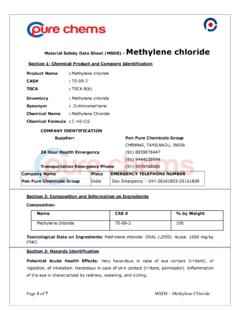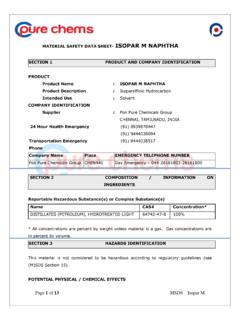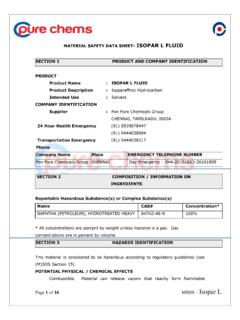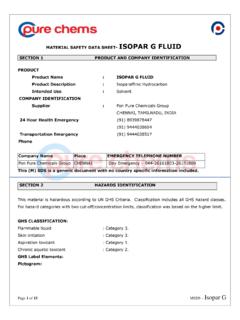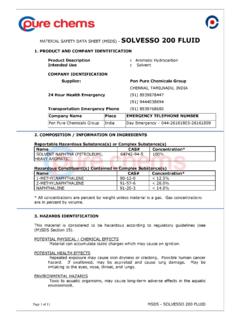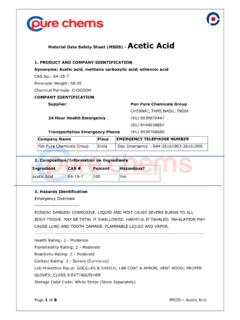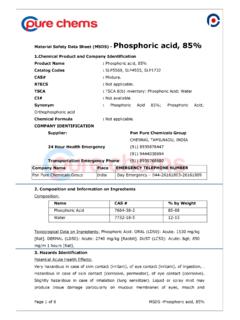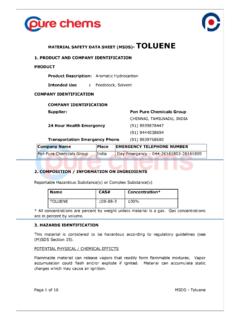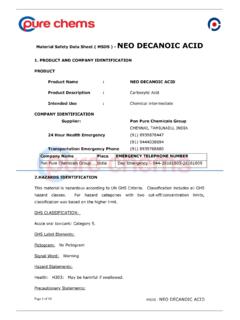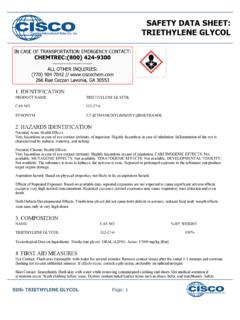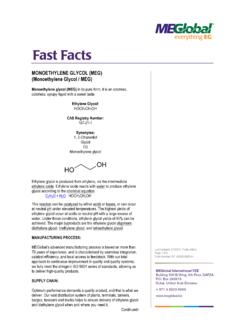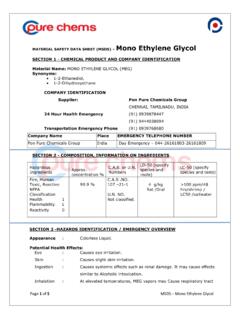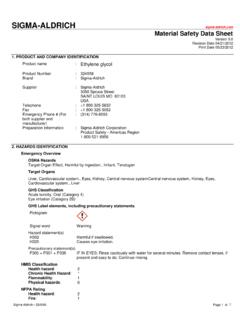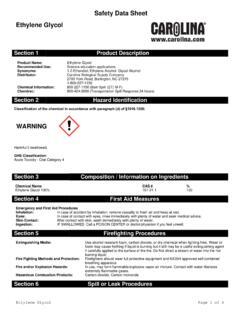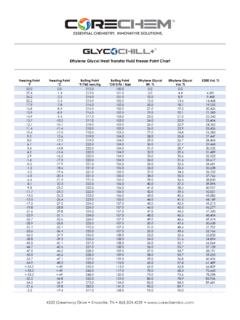Transcription of Material Safety Data Sheet (MSDS) - Mono Ethylene glycol
1 MSDS- Mono Ethylene glycol Page 1 of 8 Material Safety Data Sheet (MSDS) - Mono Ethylene glycol 1. Chemical Product and Company Identification Product Name : Mono Ethylene glycol Catalog Codes : SLE1072 CAS# : 107-21-1 RTECS : KW2975000 TSCA : TSCA 8(b) inventory: Ethylene glycol CI# : Not available. Synonym : 1,2-Dihydroxyethane; 1,2-Ethanediol; 1,2-Ethandiol; Ethylene dihydrate; glycol alcohol; Monoethylene glycol ; Tescol Chemical Formula : HOCH2CH2OH COMPANY IDENTIFICATION Supplier: Pon Pure Chemicals Group CHENNAI, TAMILNADU, INDIA 24 Hour Health Emergency (91) 8939878447 (91) 9444038694 Transportation Emergency Phone (91) 8939768680 Company Name Place EMERGENCY TELEPHONE NUMBER Pon Pure Chemicals Group India Day Emergency 044-26161803-26161809 2. Composition and Information on Ingredients Composition: Name CAS # % by Weight Ethylene glycol 107-21-1 100 Toxicological Data on Ingredients: Ethylene glycol : ORAL (LD50): Acute: 4700 mg/kg [Rat].
2 5500 mg/kg [Mouse]. 6610 mg/ kg [Guinea pig]. VAPOR (LC50): Acute: >200 mg/m 4 hours [Rat]. 3. Hazards Identification Potential Acute Health Effects: Hazardous in case of ingestion. Slightly hazardous in case of skin contact (irritant, permeator), of eye contact (irritant), of inhalation. Severe over-exposure can result in death. Potential Chronic Health Effects: CARCINOGENIC EFFECTS: A4 (Not classifiable for human or animal.) by ACGIH. MSDS- Mono Ethylene glycol Page 2 of 8 MUTAGENIC EFFECTS: Mutagenic for mammalian somatic cells. Non-mutagenic for bacteria and/or yeast. TERATOGENIC EFFECTS: Not available. DEVELOPMENTAL TOXICITY: Not available. The substance may be toxic to kidneys, liver, central nervous system (CNS). Repeated or prolonged exposure to the substance can produce target organs damage. Repeated exposure to a highly toxic Material may produce general deterioration of health by an accumulation in one or many human organs.
3 4. First Aid Measures Eye Contact: Check for and remove any contact lenses. In case of contact, immediately flush eyes with plenty of water for at least 15 minutes. Cold water may be used. Get medical attention if irritation occurs. Skin Contact: Wash with soap and water. Cover the irritated skin with an emollient. Get medical attention if irritation develops. Cold water may be used. Serious Skin Contact: Not available. Inhalation: If inhaled, remove to fresh air. If not breathing, give artificial respiration. If breathing is difficult, give oxygen. Get medical attention immediately. Serious Inhalation: Not available. Ingestion: Do NOT induce vomiting unless directed to do so by medical personnel. Never give anything by mouth to an unconscious person. If large quantities of this Material are swallowed, call a physician immediately. Loosen tight clothing such as a collar, tie, belt or waistband.
4 Serious Ingestion: Medical Conditions Aggravated by Exposure: Persons with pre-existiing kidney, respiratory, eye, or neurological problems might be more sensitive to Ethylene glycol . Notes to Physician: 1. Support vital functions, correct for dehydration and shock, and manage fluid balance. 2. The currently recommended medical management of Ethylene glycol poisoning includes elimination of Ethylene glycol and metabolites. Elimination of Ethylene glycol may be achieved by the following methods: a. Emptying the stomach by gastric lavage. It is useful if initiated within < 1 of ingestion. b. Correct metabolic acidosis with intravenous administration of sodium bicarbonate, adjusting the administration rate accoridng to repeated and frequent measurement of acid/base status. c. Administer ethanol (orally or by IV (intravenously)) or fomepizole MSDS- Mono Ethylene glycol Page 3 of 8 (4-methylpyrazole or Antizol)) therapy by IV as an antidote to inhibit the ormation of toxic metabolites.
5 D. If patients are diagnosed and treated early in the course with the above methods, hemodialysis may be avoided if fomepizole or ethanol therapy is effective and has corrected the metabolic acidosis, and no renal failure is present. However, once severe acidosis and renal failure occured, however, hemodialysis is necessary. It is effective in removing Ethylene glycol and toxic metabolites, and correcting metabolic acidosis. 5. Fire and Explosion Data Flammability of the Product : May be combustible at high temperature. Auto-Ignition Temperature : 398 C ( F) Flash Points : CLOSED CUP: 111 C ( F). (Tagliabue.) Flammable Limits : LOWER: Products of Combustion : These products are carbon oxides (CO, CO2). Fire Hazards in Presence of Various Substances: Slightly flammable to flammable in presence of open flames and sparks, of heat. Non-flammable in presence of shocks.
6 Explosion Hazards in Presence of Various Substances: Risks of explosion of the product in presence of mechanical impact: Not available. Risks of explosion of the product in presence of static discharge: Not available. Fire Fighting Media and Instructions: SMALL FIRE: Use DRY chemical powder. LARGE FIRE: Use water spray, fog or foam. Do not use water jet. Special Remarks on Fire Hazards: Not available. Special Remarks on Explosion Hazards: Explosive decomposition may occur if combined with strong acids or strong bases and subjected to elevated temperatures. 6. Accidental Release Measures Small Spill: Dilute with water and mop up, or absorb with an inert dry Material and place in an appropriate waste disposal container. Finish cleaning by spreading water on the contaminated surface and dispose of according to local and regional authority requirements. Large Spill: Stop leak if without risk.
7 Do not get water inside container. Do not touch spilled Material . Use water spray to reduce vapors. Prevent entry into sewers, basements or confined areas; dike if needed. Eliminate all ignition sources. Call for assistance on disposal. Finish cleaning by spreading water on the contaminated surface and allow to MSDS- Mono Ethylene glycol Page 4 of 8 evacuate through the sanitary system. Be careful that the product is not present at a concentration level above TLV. Check TLV on the MSDS and with local authorities. 7. Handling and Storage Precautions: Keep away from heat. Keep away from sources of ignition. Empty containers pose a fire risk, evaporate the residue under a fume hood. Ground all equipment containing Material . Do not ingest. Do not breathe gas/fumes/ vapor/spray. Wear suitable protective clothing. If ingested, seek medical advice immediately and show the container or the label.
8 Keep away from incompatibles such as oxidizing agents, acids, alkalis. Storage: Keep container tightly closed. Keep container in a cool, well-ventilated area. Hygroscopic 8. Exposure Controls/Personal Protection Engineering Controls: Provide exhaust ventilation or other engineering controls to keep the airborne concentrations of vapors below their respective threshold limit value. Ensure that eyewash stations and Safety showers are proximal to the work-station location. Personal Protection: Safety glasses. Synthetic apron. Gloves (impervious). For most conditions, no respiratory protection should be needed. However, if Material is heated or sprayed and if atmospheric levels exceed exposure guidelines, use an approved vapor (air purifying) respirator. Personal Protection in Case of a Large Spill: Splash goggles. Full suit. Boots. Gloves. Suggested protective clothing might not be sufficient; consult a specialist BEFORE handling this product.
9 Exposure Limits: STEL: 120 (mg/m3) [Australia] TWA: 100 (mg/m3) from ACGIH (TLV) [United States] CEIL: 125 (mg/m3) from OSHA (PEL) [United States] CEIL: 50 (ppm) from OSHA (PEL) [United States] TWA: 52 STEL: 104 (mg/m3) [United Kingdom (UK)] Inhalation TWA: 10 (mg/m3) [United Kingdom (UK)] SKIN3 Consult local authorities for acceptable exposure limits. and Chemical Properties Physical state and appearance : Liquid. (syrupy) Odor : Odorless. Taste : Mild sweet Molecular Weight : g/mole MSDS- Mono Ethylene glycol Page 5 of 8 Color : Clear Colorless. pH (1% soln/water) : Not available. Boiling Point : C ( F) Melting Point : -13 C ( F) Critical Temperature : Not available. Specific Gravity : (Water = 1) Vapor Pressure : .06 mmHg @ 20 C; mmHg at 25 C Vapor Density : (Air = 1) Volatility : Not available. Odor Threshold : Not available. Water/Oil Dist.
10 Coeff. : The product is more soluble in water; : log(oil/water) = Ionicity (in Water) : Not available. Dispersion Properties : See solubility in water, acetone. Solubility: Soluble in cold water, hot water, acetone. Slightly soluble in diethyl ether. Miscible with lower aliphatic alcohols, glycerol, acetic acid, acetone and similar ketones, aldehydes, pyridine, similar coal tar bases. Practically insoluble in benzene and its homologs, chlorinated hydrocarbons, petroleum ether. 10. Stability and Reactivity Data Stability : The product is stable. Instability Temperature : Not available. Conditions of Instability : Excess heat, incompatible materials. Incompatibility with various substances: Reactive with oxidizing agents, acids, alkalis. Corrosivity : Non-corrosive in presence of glass. Special Remarks on Reactivity : Hygroscopic. Absorbs moisture from the air. Avoid contamination with materials with hydroxyl compounds.
